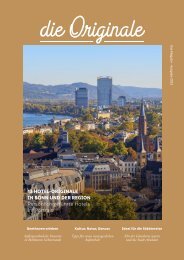LUXAIR_LUXiClub_So12 ls
p o
p
o
You also want an ePaper? Increase the reach of your titles
YUMPU automatically turns print PDFs into web optimized ePapers that Google loves.
Number 43, Fall 2002
cartographic perspectives
mounde” from The Strait of Anian: “Harrows that mere more that squares
our map” (line 3: italics mine). 8 This earlier version of the poem seems to
mean “that sea—the one that squares our map—torments us more than
the ‘shiptamed’ one we are now crossing.” Yet the very rectangularity of
its sea prevents the Anglo-Saxon map from having room for anything at
the corners, an option on the nearly ubiquitous circular or oval worldmaps.
It is precisely that extra space that Birney wanted to emphasize
when he revised the line to read “Harrows that mere more which squares
our map” (italics mine). Instead of referring back to the poem’s previous
lines, the revised sentence looks ahead to his catalogue describing “those
strange designs which scribes placed in the corners of that perilous sea”
(Birney 1972, 84).
Italian mapmakers of the fourteenth and fifteenth centuries are especially
noteworthy for this feature. Pietro Vesconte, the earliest chartmaker
known to us by name, worked in Venice. On four of the early fourteenthcentury
atlases ascribed either to him or to Perrino Vesconte, portraits
of saints illuminate the corners of the portolan charts. 9 (The portolano, or
early nautical chart, with its geographical accuracy and usefulness for both
navigation and trade, its distinctive windroses and network of intersecting
rhumb lines, is now treated separately from the mappamundi. In the thirteenth
and fourteenth centuries, however, the term mappa mundi embraced
both allegorical world maps and practical sea charts based on compass
readings. [Woodward 1987, 287; Campbell 1987, 439]) There is also a
fascinating anonymous 1390 Venetian atlas, which pictures the authors
of the gospels in the corners of at least one of its portolan charts (Mollat
and Roncière 1984, fig.10 and 204). Each evangelist appears as one of the
six-winged, many-eyed creatures from the Book of Revelation. In the Bible,
they stand beside God’s throne proclaiming his eternal glory (Revelation
4:7, in [Bible] 1973):
the first living creature like a lion, the second living creature like an ox,
the third living creature with the face of a man, and the fourth living
creature like a flying eagle.
On the chart, each saint presides over one of the earth’s four corners, and
each holds a scroll bearing his name (Woodward 1987, 336).
The figures on this chart help us read the 1452 mappamundi of the
Venetian cosmographer, Giovanni Leardo, who incorporated portolan
rhumb lines into his world map (Campbell 1987, 379 n.71). Part of the
left side of the Leardo map is missing and the figures in the corners are
unnamed, but the vague images of the evangelists are recognizable. The
Leardo map arranges its figures differently than the anonymous 1390
portolan: Mark, the lion, appears in the southeast (upper right); Luke,
the ox, in the southwest (lower right); Matthew, looking like an angel, in
the northwest (lower left); and John, the eagle, in the northeast (only his
head is visible: upper left). Furthermore, the Leardo map emphasizes the
interconnectedness of time and space, an intimacy as explicit on mappaemundi
as in Birney’s phrase “that sea is hight Time.” Leardo’s evangelists
frame not only the circular world map but also a number of calendrical
rings emanating from it. The central ring, for instance, specifies the dates
of every Easter until 1547 (Wright 1928, 3-4; Woodward 1987, 338, cf.
355).
In addition to the Italian maps, Birney had an English source that
predates them—the twelfth-century Sawley map, formerly known as
the Henry of Mainz mappamundi (Figure 5, page 69). In contrast to the
Anglo-Saxon map, which scholars consider heavily indebted to Roman
“There is also a fascinating
anonymous 1390 Venetian
atlas, which pictures the
authors of the gospels in the
corners of at least one of its
portolan charts.”
“The Leardo map emphasizes
the interconnectedness of time
and space, an intimacy as
explicit on mappaemundi as
in Birney’s phrase ‘that sea is
hight Time.’”
“In addition to the Italian
maps, Birney had an English
source that predates them—the
twelfth-century Sawley map,
formerly known as the Henry of
Mainz mappamundi.”















